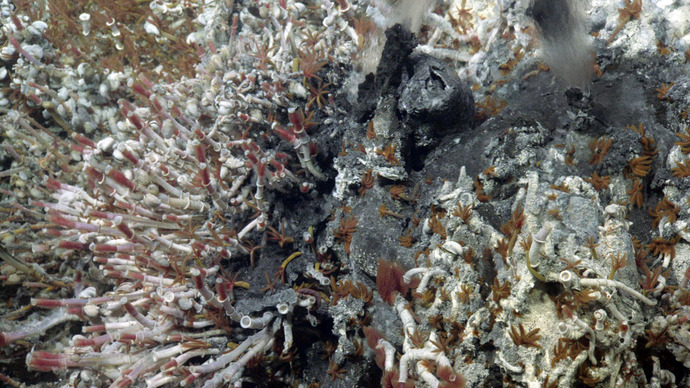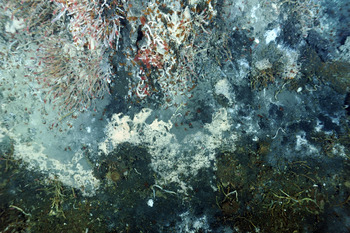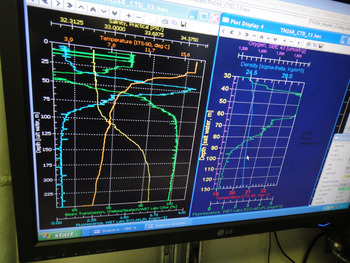Exploring the International District Vent Field
Friday, August 26, 2011

The black smoker "El Guapo" (the handsome one) rises 60 feet above the surrounding seafloor

The base of the small, 4 meter tall structure called Mushroom, is encased in a dense covering of tubeworms, palmworms, and limpets. Other life seen in this image includes a sea anemone, and "spiders of the deep" called pycnogonids.

A real time CTD record in the computer laboratory on the R/V Thompson as the rosett was being lowered to 10 meters above the seafloor at the International District vent field. The CTD vertical cast was done over the ~60 foot tall black smoker called "El Guapo". It record shows salinity (yellow), temperature (orange), Flourescence (blue-chlorophyll) and particulates in the water column (green).
Cable route and ASHES: Following another cable-route survey across the caldera of Axial Seamount this morning, the rest of the dive was spent working in the ASHES hydrothermal field imaging the black smokers in detail and taking a couple sulfide samples for investigation of the novel microorganisms that thrive within the interior and outer walls of the chimneys. One major finding was that the eruption extended farther to the north than previously believed. Upon recovery of ROPOS on deck a CTD vertical water cast was completed over “El Guapo”, a massive black smoker edifice in the International District hydrothermal field that towers nearly 60 feet above the surrounding seafloor.
International District: Tonight, ROPOS will dive in the International District to first deploy a full-size (8-ft long) test frame designed and built by the UW Applied Physics Laboratory. This frame will eventually house equipment to provide power and data transmission to/from the sensors. We will then “reacquaint” ourselves with this hydrothermal field so that we can easily come back to the black smokers at the end of the dive. ROPOS will then transit a couple kilometers to the north to determine an optimal extension cable route from Primary Node PN3B to the International District and will examine a couple other possible sites for deployment of PN3B. We will then return to the International District and recover temperature sensors that have been recording temperatures of black smokers since last year. We are very anxious to see if the eruption perturbed the temperatures of the vents. We anticipate more stunning images of black smokers and their associated biological communities. The dive will end with the recovery of the test frame and is expected to last through tomorrow morning.

